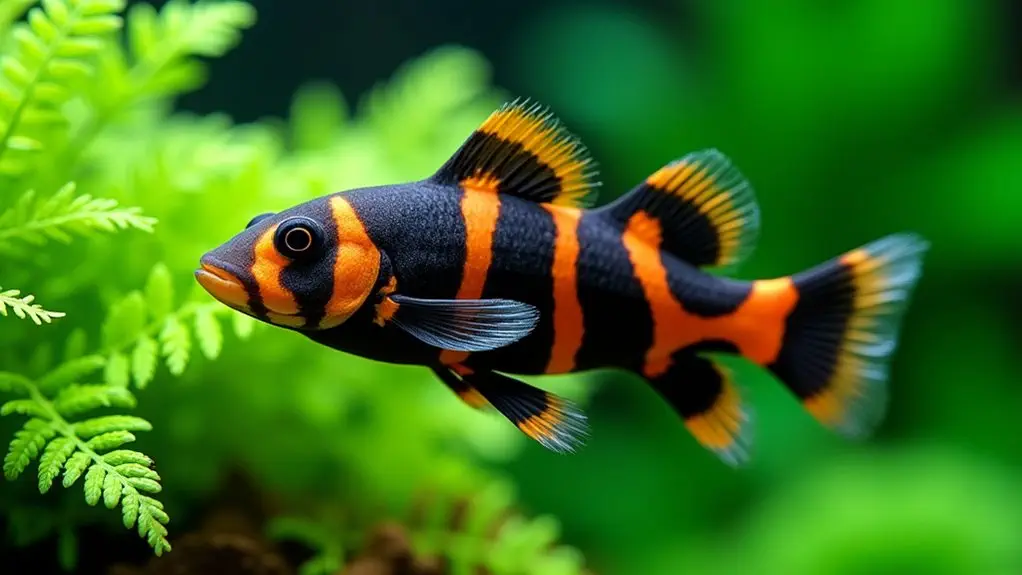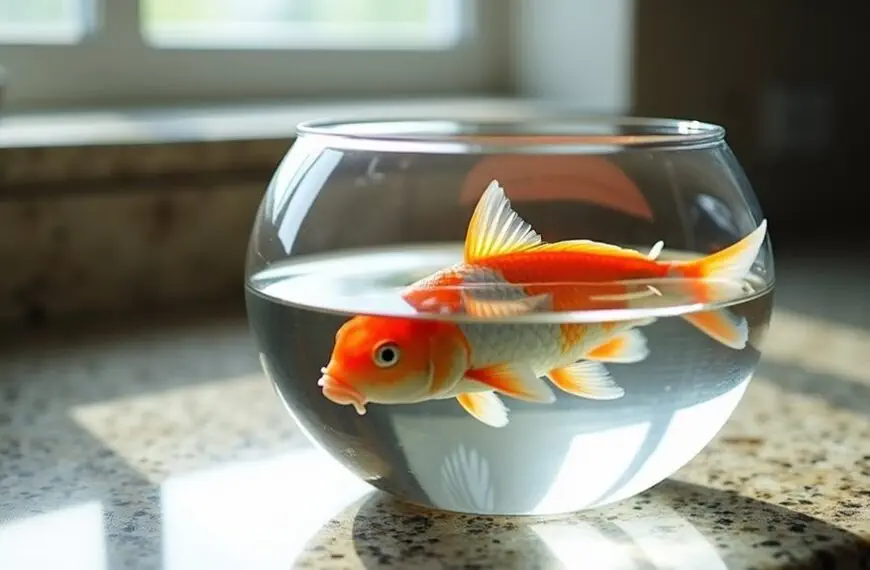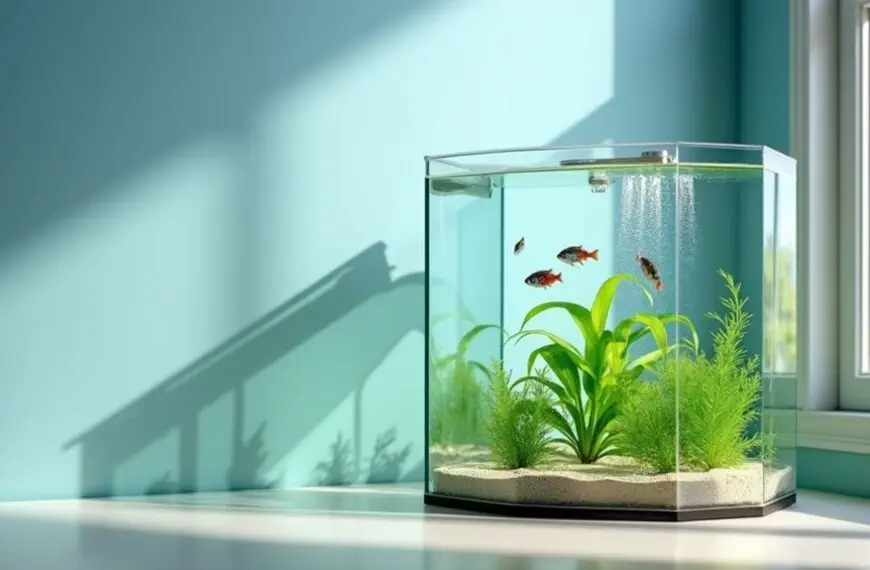Several tropical fish species are known for their incredible hardiness and adaptability in home aquariums. You'll find Zebra Danios, Platies, and White Cloud Minnows leading the pack, thanks to their robust immune systems and ability to thrive in various water conditions. Other tough contenders include Cherry Barbs, Harlequin Rasboras, and the ever-popular Guppies and Mollies, which can handle less-than-perfect tank conditions with ease. Most of these fish are peaceful community dwellers that'll get along with tankmates, making them perfect for beginners. Better yet, they're relatively low-maintenance and disease-resistant, though there's much more to discover about their unique characteristics.
Contents
- 1 Understanding Hardy Tropical Fish
- 2 Top Hardy Community Fish
- 3 Essential Tank Requirements
- 4 Best Hardy Catfish Species
- 5 Temperature and Water Parameters
- 6 Hardy Fish Disease Resistance
- 7 Maintenance and Care Tips
- 8 Hardy Fish Feeding Habits
- 9 Tank Size Considerations
- 10 Large Hardy Fish Options
- 11 Frequently Asked Questions
- 11.1 Can Hardy Tropical Fish Survive Power Outages During Winter?
- 11.2 Do Hardy Fish Species Get Along With Invertebrates Like Shrimp?
- 11.3 How Long Do Hardy Tropical Fish Typically Live in Home Aquariums?
- 11.4 Which Hardy Fish Are Best for Outdoor Ponds in Temperate Climates?
- 11.5 Can Hardy Tropical Fish Be Kept With Coldwater Species Like Goldfish?
- 12 Final Thoughts
Understanding Hardy Tropical Fish
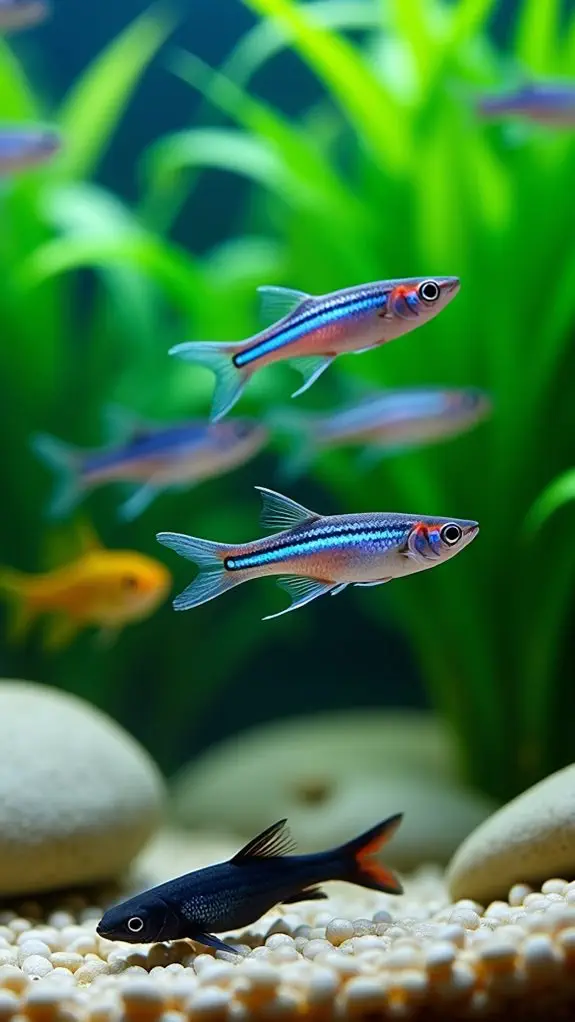
Hardy tropical fish stand out as excellent choices for both novice and experienced aquarists due to their remarkable resilience and adaptability. You'll find these aquatic champions can handle a wide range of water conditions, making them perfect for those moments when your tank's parameters aren't quite perfect (we've all been there!). Poor water quality remains the top reason for fish deaths in home aquariums.
What makes these fish so special is their incredible ability to adapt to various environments, which directly influences their fish behavior. They're like the superheroes of the aquarium world, equipped with natural defenses against common diseases and stress factors. The Zebra Danio species particularly exemplifies this hardiness with their exceptional disease resistance. Additionally, many beginners opt for beginner-friendly fish like guppies and neon tetras due to their ease of care.
Through careful breeding practices over generations, many species have developed even stronger resistance to typical aquarium challenges.
You'll be amazed at how these hardy fish can thrive in both hard and soft water, and they won't throw a fin-fit if the temperature fluctuates slightly.
Their versatility extends to tank size requirements too – they're typically more forgiving about their living space than their delicate cousins.
While they're tough enough to handle less-than-ideal conditions, you'll still want to maintain good water quality to keep them at their happiest and healthiest. After all, even superheroes need proper care!
Top Hardy Community Fish
Building on our understanding of resilient aquarium inhabitants, let's explore some specific fish species that excel in community tanks.
When it comes to hardy fish compatibility, you'll find that Zebra Danios are true champions, adapting to various water conditions while bringing constant energy to your aquarium. They're like the social butterflies of the fish world, always darting around and playing well with others. The White Cloud Minnow, scoring an impressive 36 points for hardiness, shares similar peaceful schooling behaviors.
For peaceful community fish behavior, you can't go wrong with Cherry Barbs and Harlequin Rasboras. They're the perfect neighbors, swimming gracefully in groups and rarely causing any drama in your underwater community. Most barbs are active schooling fish that require plenty of swimming space and hiding spots to thrive.
Platies are another excellent choice, as they're well-mannered citizens who'll get along swimmingly with most tankmates.
If you're dealing with hard water, don't worry! Guppies and Mollies will thrive in those conditions, adding vibrant colors and personality to your aquarium.
For the top level of your tank, consider the energetic Leopard Danio or the fascinating Silver Hatchetfish. They'll keep things lively up there while maintaining perfect harmony with your aquatic family.
Essential Tank Requirements
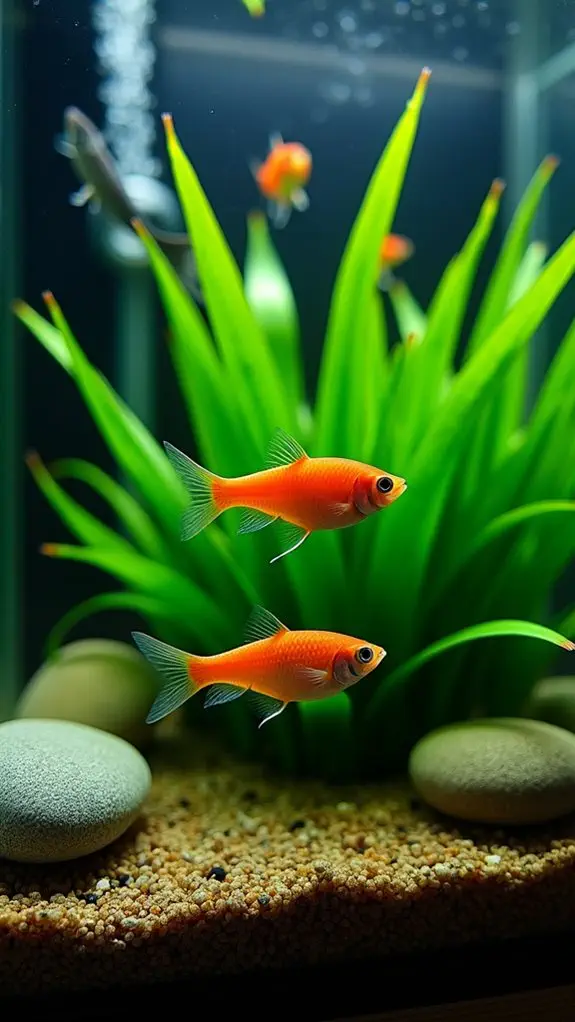
You'll want to keep your tropical fish happy and healthy by maintaining ideal water parameters between 18-28°C and regularly testing for ammonia, nitrite, and nitrate levels.
Getting the right tank size is essential – remember that bettas need at least 5 gallons while angelfish require 20 gallons or more. Small tanks up to 20 gallons will have a filled weight range of 62-225 pounds. A proper aquarium stand is crucial since warranties may be voided without appropriate support.
A good filtration system paired with regular water changes will help you maintain crystal-clear water and keep your finned friends swimming comfortably in their home.
Water Parameters and Maintenance
In any successful aquarium setup, maintaining proper water parameters is absolutely critical for fish survival. You'll need to monitor water quality regularly through testing, paying close attention to pH stability, hardness levels, and temperature consistency. Testing your water hardness with a complete dip test kit will help ensure GH and KH levels remain suitable for your fish species.
Think of it as creating the perfect home for your finned friends – they won't thrive if the conditions aren't right! Maintaining stable water conditions will help prevent unnecessary stress on your fish.
For most tropical fish, you'll want to keep your pH between 6.5-7.5 and temperature between 72-82°F. Don't forget to check for ammonia toxicity (which should always be at 0 ppm) and maintain proper nitrate control below 40 mg/L. Regular testing is your best friend here – aim to check these parameters at least weekly.
Water conditioning is essential when doing water changes, as tap water contains chemicals that can harm your fish. You'll need to treat new water with a conditioner to remove chlorine and chloramines.
Tank Size and Filtration
Selecting the right tank size and filtration system forms the foundation of a successful tropical aquarium. When you're planning your setup, you'll need to evaluate tank dimensions carefully – remember, those little fish you buy today won't stay tiny forever! A 20-gallon tank might work for a handful of small fish, but you'll want to size up to at least 40 gallons if you're dreaming of a diverse community. A good rule to follow is allowing one inch per gallon when stocking your aquarium. Make sure to account for group-oriented fish that thrive better in schools, which may necessitate a larger tank. Proper installation requires checking that your floors can support the weight, as floor jacks may be necessary for larger setups.
Your filtration types should include mechanical, chemical, and biological components working together to keep your water crystal clear. Think of it as your tank's life support system – you wouldn't want to skimp on that! A quality filter is vital for removing toxins and keeping the water clear, so ensure you meet the recommended filtration capacity.
Here's what you'll need for a healthy tank setup:
- A filter rated for at least 1.5 times your tank's volume
- Adequate swimming space with both open areas and hiding spots
- Proper height for tall-growing fish like angelfish
- Easy access points for maintenance and equipment cleaning
Best Hardy Catfish Species
When you're starting your tropical fish journey, you'll find that hardy catfish species offer some of the most rewarding experiences for beginners.
The Clown Pleco and Pictus Catfish stand out as excellent starter choices, thanks to their adaptable nature and straightforward care requirements that won't leave you scratching your head.
While these friendly bottom-dwellers need specific tank setups with soft sand and plenty of hiding spots, they'll reward your attention with years of entertaining activity and natural tank maintenance as they help keep your aquarium clean. Maintaining optimal water parameters is crucial for ensuring their health and longevity in your aquarium.
Top Beginner-Friendly Catfish Species
These five hardy catfish species stand out as perfect choices for beginners due to their adaptability and easy care requirements.
You'll find that each species brings its own unique charm to your aquarium, from the striking Sailfin Pleco with its majestic dorsal fin to the adorably tiny Otocinclus Catfish with its protruding eyes.
- The Bumblebee Catfish sports a eye-catching yellow and black pattern that'll make it the star of your tank.
- Pictus Catfish showcase elegant spotted patterns with silvery accents.
- Sterbai Corydoras charm observers with their quirky "blinking" behavior.
- Bandit Cory Catfish thrive in social groups, making them perfect community tank residents.
When it comes to catfish behavior, you'll notice these species are generally peaceful and compatible with various tank companions. It's important to maintain suitable water parameters to ensure their well-being.
The Pictus Catfish, at 4 inches, makes an ideal mid-sized addition, while the tiny Otocinclus, barely reaching 2 inches, fits perfectly in smaller setups.
If you're looking for a showstopper, the Sailfin Pleco grows to an impressive 19 inches, though you'll need to guarantee your tank can accommodate its size.
Maintenance and Tank Requirements
Proper tank setup forms the foundation for keeping hardy catfish species healthy and thriving.
You'll need to carefully consider tank size, as these armored beauties require specific spatial dimensions – generally six times their adult length in tank length and twice their width for comfortable swimming. For most species, you're looking at a minimum 20-gallon setup, though some larger species like Gold Nugget Plecos need at least 55 gallons.
When it comes to substrate selection, soft, fine sand is your best friend. Your catfish will thank you for this gentle bottom layer that protects their sensitive barbels as they scavenge for food.
For ideal catfish compatibility, you'll want to maintain water temperatures between 70-80°F and pH levels from 6.0 to 8.0. Don't skimp on filtration – external power filters are essential for managing waste and maintaining strong water flow that these fish love.
Remember to cycle your tank thoroughly before adding your catfish – they're not fans of new tank syndrome. A well-established aquarium with mature filtration will give your whiskered friends the best chance at a happy, healthy life. Additionally, maintaining optimal water quality is crucial for preventing stress and illness in your catfish.
Temperature and Water Parameters
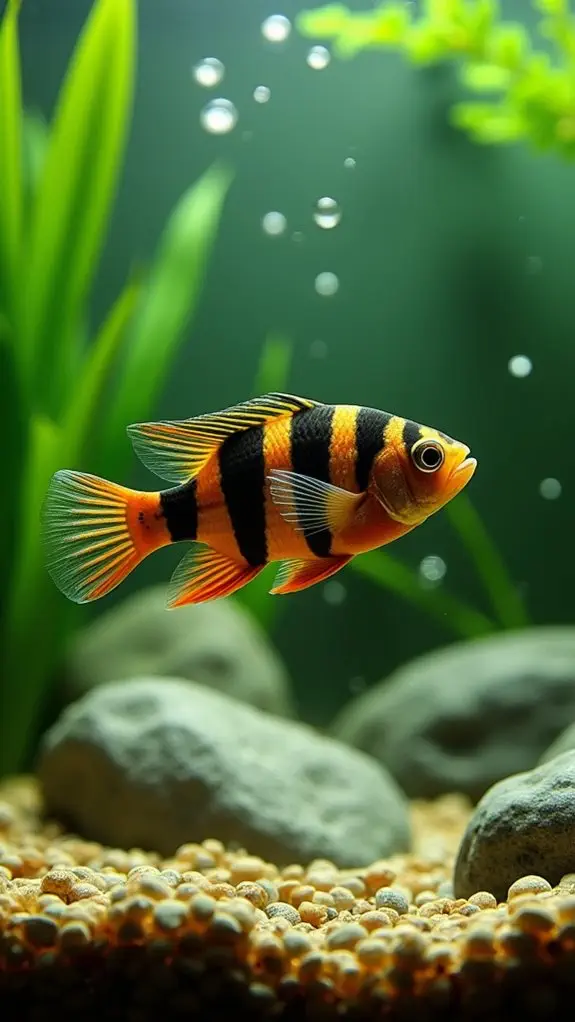
Temperature management stands at the heart of successful tropical fish keeping, with most species thriving between 24-27°C (75-80°F).
You'll find that hardy tropical fish can handle temperature fluctuations within reason, but maintaining consistency is key to their long-term health.
When you're selecting fish for your community tank, pay close attention to species compatibility, especially regarding their preferred temperature ranges.
Most aquarium heaters come preset to 25°C (78°F), which works perfectly for a wide variety of tropical fish.
You'll want to monitor your tank's temperature regularly and verify your heating equipment is working properly to prevent any sudden changes that could stress your fish.
Here's what you need to know about temperature requirements for different hardy species:
- Bettas are temperature champions, comfortable in the 24-27°C range
- Barbs show excellent adaptability between 24-26°C
- Tetras handle slightly cooler waters, thriving at 22-25.5°C
- Most catfish species prove incredibly resilient, managing well between 22-27.75°C
Fish health is crucial, as lower dissolved oxygen levels in warmer water can lead to increased stress and vulnerability to diseases.
Hardy Fish Disease Resistance
When you're setting up a community aquarium, you'll want to choose fish that naturally fight off diseases and stay healthy even when conditions aren't perfect.
Disease-resistant species like Zebra Danios, Rosy Barbs, and Variatus Platies will give you peace of mind since they've got built-in immunity that helps them ward off common aquarium illnesses. These natural immunity champions don't just survive – they thrive, making them perfect picks for both beginners and experienced fish keepers who'd rather spend time enjoying their aquarium than treating sick fish. Additionally, social behavior in these species contributes to their resilience, as they thrive in groups and help reduce stress levels in the tank.
Disease-Fighting Community Fish
Disease resistance plays an essential role when selecting hardy community fish for your aquarium.
You'll want to choose fish that can handle the natural ups and downs of community tank life while maintaining strong immune systems. Zebra Danios and Rosy Barbs are excellent choices, as they're naturally equipped to fight off common ailments like ich and columnaris.
When it comes to disease management and community dynamics, you'll find these fish particularly resilient:
- Barbs, which contrary to popular belief, aren't all fin nippers and actually make great community players
- Common Plecs, who'll tough it out through most water quality fluctuations while helping keep your tank clean
- Select Cichlid species that have evolved strong disease resistance
- Rosy Barbs, which come in beautiful varieties and rarely fall ill. Moreover, it's important to monitor water quality parameters to ensure a stable environment for these hardy fish.
Natural Immunity Champions
Several tropical fish species stand out from the crowd with their exceptional natural immunity systems.
You'll find that fish like zebra danios and bristlenose catfish aren't just surviving in your aquarium – they're thriving, thanks to their remarkable tropical resilience. These underwater champions come equipped with multiple layers of defense, from their protective scales to their bacteria-fighting mucus coating.
When you're looking for fish that can handle almost anything, you can't go wrong with corydoras catfish or the mighty oscar.
They've got impressive immune systems that include both innate and adaptive defenses, working together like a well-oiled machine. Their bodies are constantly producing protective compounds and maintaining ideal pH levels to ward off unwanted visitors.
What makes these natural immunity superstars even more impressive is their ability to adapt to various water conditions. Additionally, species like corydoras catfish are known for being hardy and thrive in groups, which contributes to their overall well-being.
While they're tough cookies, you'll still want to maintain stable water parameters to help their immune systems work at peak efficiency. Think of them as the superheroes of your aquarium – they're naturally equipped with special powers, but they'll perform even better when you provide them with the right environment.
Top Disease-Resistant Species
Building on these natural immunity champions, specific tropical fish species have proven themselves exceptionally resistant to common aquarium diseases. When you're looking for fish that can handle the challenges of aquarium life, you'll find that certain species stand out for their remarkable disease resistance and ability to adapt to varying water conditions.
- Zebra Danios are like the superheroes of the aquarium world, shrugging off most common illnesses with their robust immune systems.
- Rosy Barbs combine beauty with brawn, showing impressive pathogen adaptability in various water conditions.
- Bristlenose Catfish not only keep your tank clean but also rarely fall victim to common aquarium ailments.
- Oscars prove that bigger fish can be just as hardy, with their strong disease resistance mechanisms.
You'll find these species particularly valuable if you're new to the hobby or setting up a community tank. Their natural immunity, combined with their ability to maintain health even when conditions aren't perfect, makes them excellent choices for both beginners and experienced aquarists. Additionally, these species thrive best in a well-cycled tank, which is essential for establishing beneficial bacteria that support fish health.
While no fish is completely immune to illness, these species have demonstrated time and again their ability to bounce back from challenges that might seriously affect other fish.
Maintenance and Care Tips
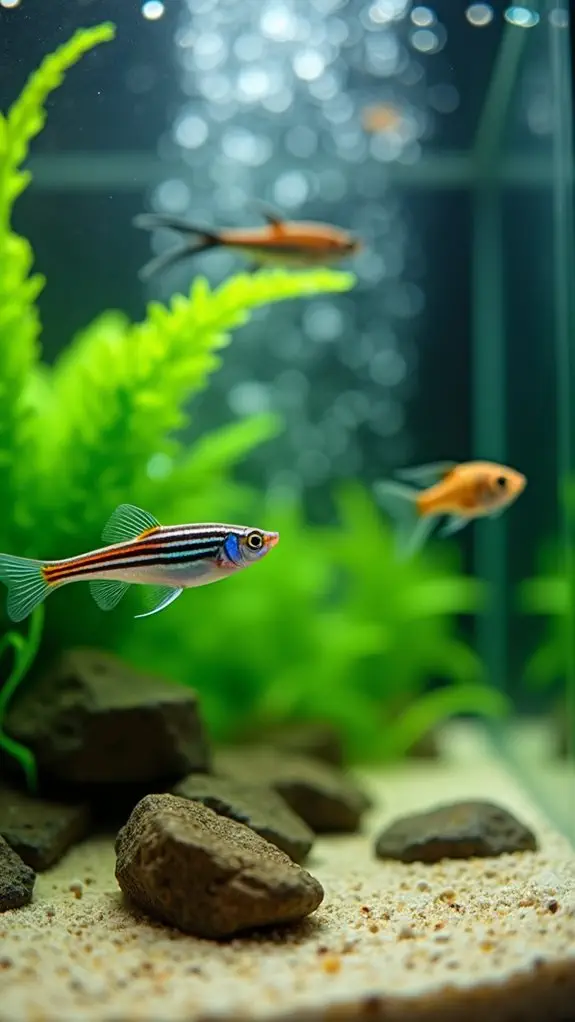
Proper maintenance forms the foundation of a healthy tropical fish aquarium. When you're setting up your tank, consider fish compatibility and thoughtful aquarium decor that includes plants, driftwood, and rocks to create natural hiding spots.
You'll want to guarantee your tank is at least 10 gallons for smaller species, with additional space needed for larger fish groups.
To keep your aquatic friends thriving, you'll need to maintain water temperatures between 72-82°F and monitor pH levels regularly.
Don't skip those weekly water changes – they're like a rejuvenating shower for your fish! Aim for 25-50% changes to remove waste and keep those pesky toxins at bay.
Testing water parameters every couple of weeks isn't just busy work; it's your early warning system for potential problems.
Remember to cycle your new tank before adding fish – think of it as preparing a cozy home before moving day.
Keep an eye on your fish for any signs of stress or illness, and don't forget to add some algae-eating buddies to your cleanup crew.
With consistent care and attention to detail, you'll create a thriving underwater paradise that's both beautiful and sustainable.
Hardy Fish Feeding Habits
Feeding your hardy tropical fish requires a balanced approach that combines proper timing and portion control.
You'll want to establish a consistent feeding frequency of once or twice daily for most species, though some fish like goldfish may need several smaller meals throughout the day.
When it comes to food types, it's best to mix things up with a combination of flakes, pellets, and frozen foods to guarantee your fish get all the nutrients they need.
Here's what you'll notice about hardy fish feeding habits:
- They're typically not picky eaters and will enthusiastically accept most commercial foods
- They can adapt to different feeding schedules, making them perfect for busy owners
- They show clear signs when they're hungry, like gathering at the surface
- They'll quickly learn when it's feeding time and may even recognize you
Remember to only feed what your fish can eat within five minutes, and don't worry if they seem like they're always begging for more – they're just being opportunistic!
Remove any uneaten food promptly to maintain water quality, and you'll have happy, healthy fish that'll thrive in your aquarium for years to come.
Tank Size Considerations
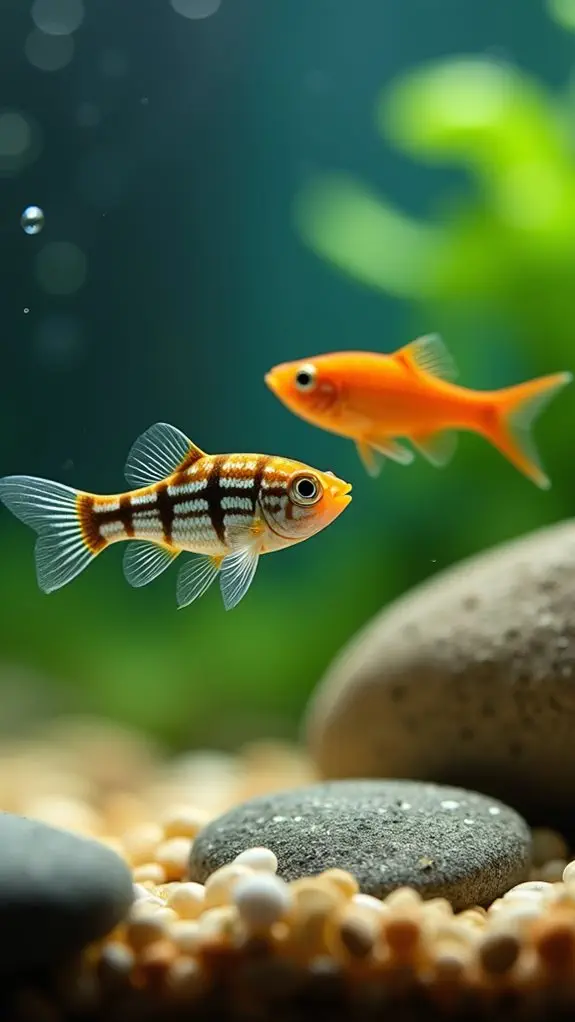
Selecting the right tank size follows naturally from understanding your fish's feeding habits, as both directly impact their well-being. When you're setting up your aquarium, you'll want to follow the general rule of one gallon per inch of fish, but there's more to take into account than just this basic guideline.
Tank shape and species compatibility play important roles in creating a happy home for your aquatic friends. If you're keeping active swimmers like danios, you'll need a longer tank that gives them plenty of room to zip around. For bottom dwellers like catfish, a deeper tank setup works better. You don't want your fish feeling like they're stuck in a cramped studio apartment when they deserve a spacious loft!
Most beginners find success with 20-29 gallon tanks, as they're more forgiving if you miss a water change here and there. While it's tempting to start small, larger tanks actually make your life easier in the long run.
Plus, they give you more options for adding different species as you gain confidence in your fish-keeping journey.
Large Hardy Fish Options
While many aquarists start with smaller species, large hardy fish present unique challenges and rewards for experienced hobbyists.
If you're ready to level up your aquarium game, you'll want to take into account these impressive specimens carefully, as they've specific feeding requirements and fish compatibility needs that can't be ignored.
Here's what you'll need to know about these aquatic giants:
- The Silver Arowana is a showstopper that needs a massive 300-gallon tank and a secure lid – they're known for being jumpy!
- Jaguar Cichlids are the "tough guys" of the aquarium world, reaching two feet in length and sporting a stunning spotted pattern.
- Bala Sharks are actually peaceful schooling fish that'll get along with others, but they need plenty of swimming space.
- Fahaka Puffers are solitary characters with specific dietary needs, including shellfish on the menu.
When choosing these larger species, you'll need to commit to regular maintenance and proper feeding schedules.
Frequently Asked Questions
Can Hardy Tropical Fish Survive Power Outages During Winter?
You'll find hardy tropical fish can survive power outages if you maintain oxygen levels and use heat packs. During winter conditions, reduce feeding and consider backup power sources to protect against temperature drops.
Do Hardy Fish Species Get Along With Invertebrates Like Shrimp?
You'll find that fish compatibility varies greatly with shrimp. While some hardy species may prey on shrimp, others like Otocinclus are peaceful. Watch shrimp behavior carefully – if they're hiding, your fish aren't compatible.
How Long Do Hardy Tropical Fish Typically Live in Home Aquariums?
You'll find that hardy tropical fish lifespans vary from 3-15 years, depending on tank conditions. With proper care, small species live 3-8 years, while medium to large species can reach 10-15 years.
Which Hardy Fish Are Best for Outdoor Ponds in Temperate Climates?
For your outdoor habitats, you'll find koi and goldfish are the most reliable pond fish. They're exceptionally hardy, withstand temperature fluctuations well, and can thrive for decades with proper care in temperate climates.
Can Hardy Tropical Fish Be Kept With Coldwater Species Like Goldfish?
You shouldn't mix tropical fish with goldfish due to different temperature tolerance requirements. While some fish show broader compatibility, maintaining proper temperatures for both species is challenging and can stress your aquatic pets.
Final Thoughts
You'll find that hardy tropical fish make excellent pets for both beginners and experienced aquarists. By choosing resilient species like tetras, danios, and platies, you're setting yourself up for success. Remember to maintain proper water parameters, provide appropriate tank sizes, and stick to regular feeding schedules. With these sturdy swimmers in your aquarium, you'll enjoy a vibrant underwater community that's both beautiful and forgiving for newcomers to the hobby.

